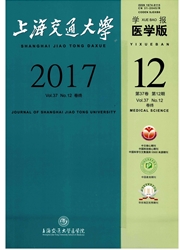

 中文摘要:
中文摘要:
目的 ·通过伪狂犬病毒(PRV)逆行示踪技术研究神经根移位术是否能够重建大鼠脊髓损伤后的排便功能。方法 ·取大鼠20只,于S1、L6神经根之间横断脊髓,10只作为对照(A组),10只行神经根移位手术(B组)。6个月后,每只大鼠注射6μL PRV,注射3 d后用多聚甲醛灌注,取出脊髓,冰冻包埋后切片观察PRV阳性标记情况。结果 ·A组于损伤平面以上脊髓切片中未发现PRV阳性标记,而B组于损伤平面以上脊髓切片中发现被PRV感染的神经元细胞。结论 ·神经根移位在大鼠脊髓损伤后排便功能的重建中具有明确作用,PRV逆行示踪技术可验证新的反射通路的存在。
 英文摘要:
英文摘要:
Objective·To investigate the effectiveness of nerve transfer in repairing defecation function after spinal cord injury by the pseudorabies virus (PRV) retrograde tracing. Methods. The spinal cords were transected between L6 and S1 nerve root in 20 rats. The nerve transferring surgery was then conducted in 10 rats (Group B) and the remaining rats were control (Group A). After six months, all rats were injected with 6/.tL PRV, sacrificed after 3 d and perfused with paraformaldehyde. Spinal cords were then harvested and frozen sections were prepared for observation. Results There was no detectable infection of PRV proximal to the injury level in Group A, while infected neurons proximal to the injury level were widely observed in Group 13. Conclusion Nerve transfer has potent effect on defecation reconstruction after spinal cord injury in rats. PRV retrograde tracing can prove the existence of new neuron pathway.
 同期刊论文项目
同期刊论文项目
 同项目期刊论文
同项目期刊论文
 期刊信息
期刊信息
